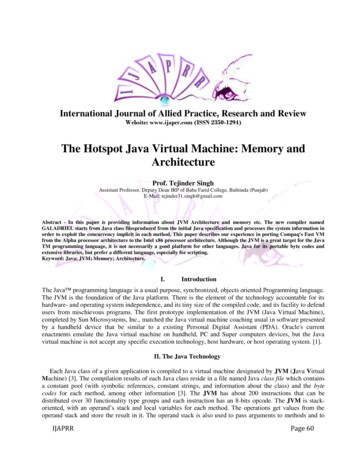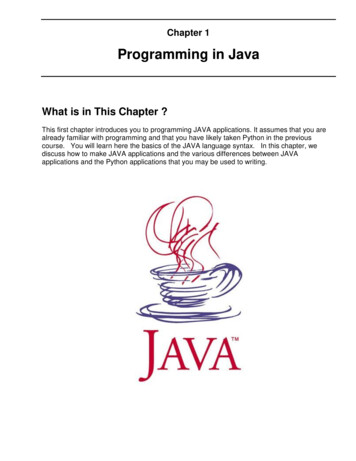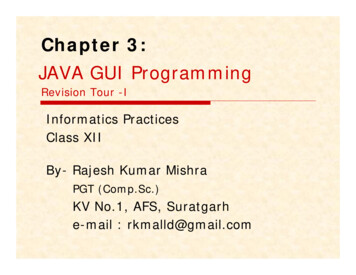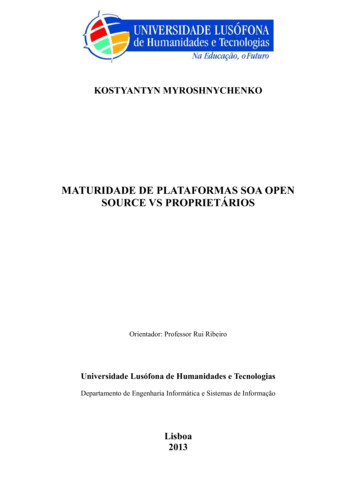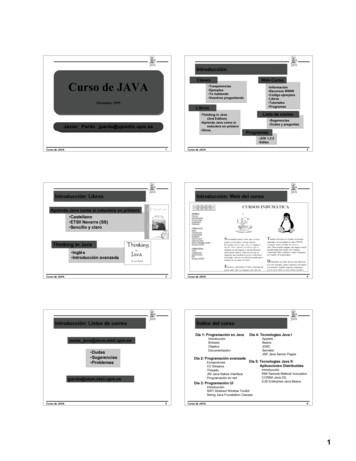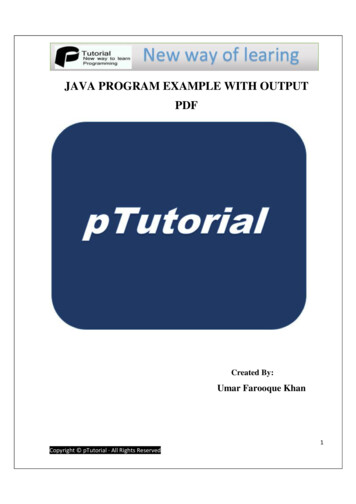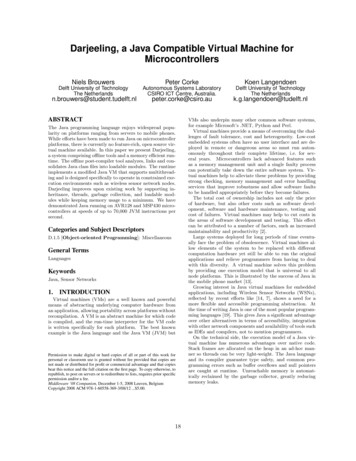
Transcription
Darjeeling, a Java Compatible Virtual Machine forMicrocontrollersNiels BrouwersPeter CorkeKoen LangendoenDelft University of TechnologyThe NetherlandsAutonomous Systems LaboratoryCSIRO ICT Centre, Australia.Delft University of TechnologyThe e@csiro.auABSTRACTThe Java programming language enjoys widespread popularity on platforms ranging from servers to mobile phones.While efforts have been made to run Java on microcontrollerplatforms, there is currently no feature-rich, open source virtual machine available. In this paper we present Darjeeling,a system comprising offline tools and a memory efficient runtime. The offline post-compiler tool analyzes, links and consolidates Java class files into loadable modules. The runtimeimplements a modified Java VM that supports multithreading and is designed specifically to operate in constrained execution environments such as wireless sensor network nodes.Darjeeling improves upon existing work by supporting inheritance, threads, garbage collection, and loadable modules while keeping memory usage to a minimum. We havedemonstrated Java running on AVR128 and MSP430 microcontrollers at speeds of up to 70,000 JVM instructions persecond.Categories and Subject DescriptorsD.1.5 [Object-oriented Programming]: MiscellaneousGeneral TermsLanguagesKeywordsJava, Sensor Networks1. INTRODUCTIONVirtual machines (VMs) are a well known and powerfulmeans of abstracting underlying computer hardware froman application, allowing portability across platforms withoutrecompilation. A VM is an abstract machine for which codeis compiled, and the run-time interpreter for the VM codeis written specifically for each platform. The best knownexample is the Java language and the Java VM (JVM) butPermission to make digital or hard copies of all or part of this work forpersonal or classroom use is granted without fee provided that copies arenot made or distributed for profit or commercial advantage and that copiesbear this notice and the full citation on the first page. To copy otherwise, torepublish, to post on servers or to redistribute to lists, requires prior specificpermission and/or a fee.Middleware ’08 Companion, December 1-5, 2008 Leuven, BelgiumCopyright 2008 ACM 978-1-60558-369-3/08/12 . 5.00.18k.g.langendoen@tudelft.nlVMs also underpin many other common software systems,for example Microsoft’s .NET, Python and Perl.Virtual machines provide a means of overcoming the challenges of fault tolerance, cost and heterogeneity. Low-costembedded systems often have no user interface and are deployed in remote or dangerous areas so must run autonomously throughout their complete lifetime, i.e. for several years. Microcontrollers lack advanced features suchas a memory management unit and a single faulty processcan potentially take down the entire software system. Virtual machines help to alleviate these problems by providingstrong checking, memory management and error handlingservices that improve robustness and allow software faultsto be handled appropriately before they become failures.The total cost of ownership includes not only the priceof hardware, but also other costs such as software development, software and hardware maintenance, testing andcost of failures. Virtual machines may help to cut costs inthe areas of software development and testing. This effectcan be attributed to a number of factors, such as increasedmaintainability and productivity [2].Large systems deployed for long periods of time eventually face the problem of obsolescence. Virtual machines allow elements of the system to be replaced with differentcomputation hardware yet still be able to run the originalapplications and relieve programmers from having to dealwith this diversity. A virtual machine solves this problemby providing one execution model that is universal to allnode platforms. This is illustrated by the success of Java inthe mobile phone market [13].Growing interest in Java virtual machines for embeddedapplications, including Wireless Sensor Networks (WSNs),reflected by recent efforts like [14, 7], shows a need for amore flexible and accessible programming abstraction. Atthe time of writing Java is one of the most popular programming languages [19]. This gives Java a significant advantageover other alternatives in terms of accessibility, integrationwith other network components and availability of tools suchas IDEs and compilers, not to mention programmers.On the technical side, the execution model of a Java virtual machine has numerous advantages over native code.Stack frames are allocated on the heap in an ad-hoc manner so threads can be very light-weight. The Java languageand its compiler guarantee type safety, and common programming errors such as buffer overflows and null pointersare caught at runtime. Unreachable memory is automatically reclaimed by the garbage collector, greatly reducingmemory leaks.
StackMultithreadingGarbageLoadableOpenJava -bityesnonoyesAmbicompVM32-bit (48)yesyesyesnoVM*32-bityesyesyesnoTable 1: JVM comparisonIn this paper we discuss a new virtual machine and toolchain that allows a significant subset of the Java languageto execute on a microcontroller of the MSP430 or ATmega128 class. These devices have 1-8 KB of RAM and about16-128 KB of program memory so a low RAM footprint iscritical.The next sections of the paper discuss prior work on VMsfor embedded microcontrollers, introduce the Java VM, andthen outline our solution for executing Java on embeddedmicrocontrollers. Our focus is the application in WSNs butour Java system can be used for any embedded microcontroller application.2. PRIOR WORKReported VM projects can be roughly divided into twogroups: traditional VMs such as Java VMs and so calledApplication Specific Virtual Machines, or ASVMs. Application specific VMs abstract common operations as instructions in a stack-based virtual machine. They trade off flexibility for code footprint, both in the VM and the applicationcode. This approach has been popular especially in the fieldof wireless sensor networks, where applications are transmitted wirelessly and small code size means reduced powerconsumption for communication. Examples of such VMs areMaté [8] and VMSCRIPT [12].A multitude of projects have focused on making Java execute on tiny platforms. An overview of these projects andtheir features is given in Table 1. We have looked at stackwidth as this influences memory consumption, support formultithreading and garbage collection, support for runtimeloadable modules (libraries) and whether these projects areopen source.Java Card [10] is an effort by SUN, the creators of Java,that targets smart cards. These platforms typically have1-2 KB of memory and about 16 KB of program memory.An interesting feature of Java Card is that it uses a stackwidth of 16 bits rather than the standard 32. This essentiallymeans it is a 16-bit JVM, which makes it more suitable formicrocontrollers.NanoVM [11] is an open-source, limited JVM written forAtmel’s AVR series of microprocessors. It can run in lessthan 8 KB of program flash, and 1 KB of memory. It wasdesigned for robot platforms and does not support moreadvanced features such as exceptions and threads and hasa limited inheritance model. TinyVM [18] was developedto bring Java support to the Lego Mindstorms RCX brick.It has many features including multithreading but unfortunately lacks garbage collection.Java has been reported for WSN applications, notablyAmbicompVM [14] and VM* [7]. The AmbiComp VM is aflexible and complete JVM. It can operate in a distributedfashion using key-based routing to address remote objects.19Stack elements carry two additional bytes with type information, making the stack width 48 bit. VM* features a fewinteresting performance optimizations. Memory limitationsare addressed by synthesizing a VM for a specific application.Of the examined projects only NanoVM and TinyVM areopen source. Upon examination neither of these proved asuitable starting point for further work.3.DARJEELINGThe Java Virtual Machine (JVM) [9] was designed specifically to execute compiled Java programs. It uses a stackbased instruction set, called bytecode to reflect the generalsize of opcodes. The stack is 32 bits wide, but 64 bit datatypes are supported by having them occupy two stack slots.Because it is a stack-based VM, code density is generallygreater than with register-based instruction sets [16]. Javais an object-oriented language and the VM supports featuressuch as class inheritance, interfaces, and virtual method invocation.The design constraints for many embedded systems, particularly wireless sensor networks, are quite different to thosefor desktops and mobile phones. One important differenceis that system RAM is limited, ranging from about 1-8 KBon most sensor node hardware. Another is that sensor nodeapplications spend most of their lifetime in sleep mode, periodically executing small segments of code. Execution speedof non time-critical applications is therefore less important.This observation has led us to actively trade off clock cyclesfor bytes on the heap, the exact reverse of many optimizations found in desktop and mobile JVMs where memory isavailable by the megabyte.When designing our Darjeeling Virtual Machine (DVM)we have chosen not to implement the full Java virtual Machine Specification. It is our philosophy that instead of scaling down the JVM to fit on our target processors, it is betterto design a new VM from the ground up and map appropriate parts of the Java platform onto it. Important tradeoffshave been compatibility, features, and performance versuscode complexity and memory usage.Darjeeling does not use the class loader system presentin Java, and as a result memory overhead is greatly reduced. Darjeeling uses a static linking model discussed inSection 3.1. Modifications have been made to the instruction set to accommodate this new linking model, supportpacking of heap objects and static variables. Support for64-bit datatypes and floating point has been omitted.Darjeeling does not support the full standard class libraries, but rather provides a small footprint, bare-essentialssystem module (“infusion”). Libraries can be added to givethe application developer control over peripherals such asthe radio. This is discussed in more depth in Section 3.4.
ID is partially resolved into a global ID by looking up theinfusion in the import list. A global ID is a tuple of a pointerto a loaded infusion, and an entity ID. The method itself cannow be retrieved from the infusion’s method list.3.2Figure 1: Infusion process3.1 Linking modelIn Java, every class is treated as a dynamically linked,loadable module. Entities, such as fields and methods, arereferenced by name, and these names are stored as string values in the class files. While this model is very flexible andallows for code updates on a per-class basis, it is also verycostly in terms of storage. Other embedded JVMs have implemented a static linking model where all application classfiles are linked together into a single binary [11], resolvingeach reference into an integer identifier. This results in binaries that are considerably smaller, but the downside ofthis approach is that common code cannot be shared acrossapplications.To achieve a small code footprint while ensuring modularity, Darjeeling uses a model where groups of classes are statically linked into loadable modules called infusions. Infusionsmay reference each other, can be loaded and unloaded at runtime, and support versioning.An application or library consisting of a group of classesis transformed in a post-compile step by a tool called the infuser. The infuser statically links Java .class files togetherand resolves names into identifiers. Classes, methods andfields are sequentially numbered. A header file is producedthat contains the mapping between the original names andthe identifiers that replace them. These header files are usedwhen one infusion imports another, and to make sure thatnew versions of infusions do not break previous dependenciesby changing identifiers.The process is illustrated in Figure 1. The Java class filesthat make up the application or library are input to theinfuser, along with the header files of imported infusions.The output consists of two files, a Darjeeling infusion file(.di) that contains the actual bytecode and a Darjeelinginfusion header (.dih) that contains a mapping between theoriginal Java entity names and the generated identifiers.The identifiers that are found in the .di files are calledlocal IDs and consist of two parts, a local infusion ID and anentity ID. The first element refers to an item in the importlist of an infusion. The second element refers to an entitywithin that imported infusion. Local IDs are stored as atwo-byte tuple. Figure 2 shows how a method is resolvedat runtime. In this example a method inside the ‘motor’infusion is called from the ‘car’ infusion. First, the local20Executable sizeBy removing the naming information we can substantiallyreduce the size of executables. Table 2 shows file sizes offour applications. The Car application is a single class thatcontrols an r/c car, SimpleApp is a token-ring applicationthat uses the radio, the system library is the system infusionthat is required by all applications to run and lastly the regression tests are a group of classes used to test Darjeeling.The first column shows the sum of the class file sizes, withthe code column showing how much of that is used for storing actual bytecode. The code/class ratio shows how muchoverhead dynamic linking information contributes for eachcase, and illustrates why we decided to remove it from ourformat. The jar column shows the compressed size of theclasses, with no manifest files included. The system libraryconsists of many classes which explains why the jar file is actually larger than the uncompressed class files, as file pathinformation was added to the archive. The size of the .difiles and the ratios versus .class and .jar files show thateven though we do not use code compression our executableformat produces files that are considerably smaller than thecorresponding .jar files.3.3Memory modelJava is in its core a 32-bit virtual machine. On the stack,in local variables, and in objects, values are stored in 32-bitslots. This is beneficial for performance on 32-bit architectures but leads to memory wastage on 8 and 16-bit microcontrollers. Most applications can use short instead of intfor counters, temporary variables and so forth. Ideally variables of type byte or short should only occupy 1 or 2 bytesrespectively instead of 4.Darjeeling packs the fields of objects on the heap, withreferences being separated from integer fields to help withgarbage collection. The instructions getfield and setfieldhave been replaced by the new instructions getfield T and setfield T , where T is one of int, short, byte orref. The offset of the field inside the object is stored asan immediate value in the instruction. A similar method isused to pack static fields, which are allocated on the heapas a part of the loaded infusion.Darjeeling uses a simple mark & sweep garbage collector.We chose this algorithm because of its simplicity, and because it does not move objects. This allows allocated Javaobjects to coexist with native objects such as stack frames.A downside is that non-compacting collectors typically causefragmentation on the heap. Another is that the mark phaseis usually implemented using recursion, which can potentially cause stack overflows. We are therefore implementinga slower but non-recursive marking algorithm.A function call causes a new stack frame to be allocatedon the heap. This stack frame contains bookkeeping such asa pointer to the parent frame, a stack, and local variables.When slots are 32-bit wide, each stack element and localvariable occupies four bytes. This causes an average stackframe to occupy in the order of 30-50 bytes. To reduce thisoverhead, it is possible to use 16-bit slots instead of 32. Thisrequires bytecode analysis and changes to the instruction set
Figure 2: Resolving a method referenceApplicationCarSimpleAppSystem libraryRegression 0.220.67Table 2: File size comparison[17]. We are planning on implementing this technique in thefuture.The .di files are placed in different memory sections ondifferent platforms. The AVR and MSP430 platforms bothhave a certain amount of program flash, but access to themis quite different. On the MSP430 for instance, reads have tobe word-aligned. On the AVR program flash is not mappedinto the general address space and reading is done through aspecial instruction. To resolve these differences a thin layerof macros is written for each platform to access a .di fileand its elements.3.4 Interaction with native codeA mechanism for calling native methods is implemented toallow Java programs to make use of the platform hardwareand interact with the virtual machine. When a method isdeclared with the native keyword, calling that method ina Java program will result in the virtual machine resolvingthe corresponding native (written in C) implementation ofthat method and executing it.The mapping between a native method declaration in Javaand a native method is generated by the infuser tool. It cangenerate a .h file that contains definitions for native methodsfound in an infusion and the identifiers that were assignedto them. Parameters to, and return values from the nativemethods are passed through the runtime stack.3.5 MultithreadingAs previously mentioned, Darjeeling was developed in thecontext of wireless sensor networks. Allowing multiple taskssuch as a network stack, routing layer and data processingapplication to be executed simultaneously is a challenge forwhich different solutions have been proposed in the field.The traditional method of supporting concurrency is bymeans of multitasking. Operating systems such as MantisOS [1] and FOS [3] provide this functionality. A drawback ofthis technique is that every thread requires a separate, preallocated stack, the size of which is equal to the worst-caseusage. TinyOS [6] and Contiki [20] solve this problem byusing event-driven concurrency. The event model has provendifficult for developers to work with however, especially asapplication complexity grows [5].The lack of support for light-weight threads in existingoperating systems is partly due to how C code is compiled21TestTree sortTree sortTime136s128sHeap890 bytes1200 bytesVM Instr.3,652,0063,652,006Instr/sec26,53328,531Table 4: Tree sort testand executed. The Darjeeling runtime allocates stack spacedynamically rather than statically. More specifically, eachstack frame is allocated as a single heap object. This mightseem inefficient in terms of memory, since in most JVM implementations the stack frame of the caller is overlappedwith the stack frame of the callee. In scenarios with manythreads however, the benefit of not having to pre-allocatestack space for each thread quickly outweighs this drawback. If the application programmer decides to use threadsynchronization to to keep threads from allocating a lot ofstack space all at the same time, these benefits can be evenmore considerable. This is illustrated in section 4.When there is not enough heap space for a function tobe called, an OutOfStackException is thrown, and the system can decide how to appropriately deal with the situation.Possible actions might be restarting the thread, blocking thethread until more memory is available, or killing a lowerpriority task.Darjeeling implements preemptive multithreading withatomic JVM instructions. Timeslicing is done by performing a context switch every n instructions, where n can bechosen freely and currently defaults to 256. Darjeeling supports thread synchronization with the Java synchronizedkeyword. Because the vast majority of objects will neveract as monitors, monitor counters are not stored in the object headers as in some other implementations but ratherlive in a separate construct to further save space.4.RESULTSIn order to quantify the performance of Darjeeling we havewritten two test applications and measured their executiontimes. The Bubblesort test is a standard O(n2 ) sorting algorithm, which we tested with an array of 500 values in reverseorder (worst case). We also tested an 8 8 vector convolution [4] executed 10,000 times. Test were written in bothJava and C and timed on an ATmega128 running at 8MHz.
TestBubble sortVector ConvolutionC0.74s2.97sJava72s421sVM VM112.18117.56Java/Native97.30141.75Table 3: Performance 2000Thread 1Thread 2Thread 3Total600Memory consumption (bytes)Memory consumption (bytes)700Thread 1Thread 2Thread 3Total050010001500200002500Time (# alloc/free operations since start)05001000150020002500Time (# alloc/free operations since start)Figure 3: Binary tree test, unsynchronizedFigure 4: Binary tree test, synchronizedThe compilers were GCC 4.2.1 for AVR and Javac from theSun JDK 1.6.The results are shown in Table 3. The first two columnsshow execution times for the C and Java programs respectively. The third column displays the number of instructions that were executed by the JVM, the next shows thenumber of instructions per second. The AVR/VM columnshows the number of AVR clocks per VM instruction, andthe Java/Native ratio quantifies the performance overheadof Java over C. The tests show a performance of about 70,000JVM instructions per second on these benchmarks.We performed a worst-case test of the JVM with a binarytree implementation. Each tree node is represented by anobject that has a byte value and references to the left andright child nodes. The tree is constructed by inserting 20random numbers, after which it is walked and the numbersare placed into an array in ascending order. This is repeated1,000 times. Both the insert and walk operations are implemented using recursion.Obviously this is not an effective way to sort, but it provides a good stress test for the virtual machine becauseit generates a large number of small objects and virtualmethod calls which triggers the garbage collector frequently.The worst-case from the perspective of memory consumption occurs when the tree is being walked and the deepestnode is being visited, as this causes a large amount of stackspace to be allocated by the main thread.From Table 4 we see that this application can run in 890bytes. In order to do that, the garbage collector is invokedtwice per iteration which reduces performance. Still theVM is able to execute about 26,500 instructions per second.When the heap is increased to 1200 bytes, the collector isinvoked only once per iteration and performance increases22to about 28,500 instructions per second.In order to illustrate how stack space is allocated dynamically rather than statically and how this effects memory consumption, we wrote an application that runs the tree sorttest concurrently in three threads. We measured the totalstack size for each thread, which we define as the size ofthe thread object plus the total size of the individual stackframe objects. The overhead of the heap manager in theform of chunk headers is included in this number. Figure3 shows the total stack size of each thread over time. Thethree individual threads each peak at 525 bytes. The totalstack space of all threads in this test peaks at 1515 bytes.The application is run again, but slightly altered. A synchronized block is added in the code so that only one threadat a time is allowed to execute the tree sort test while theother two threads remain blocked. The result is shown infigure 4. In this case the total peak consumption is 699bytes, less than half of the unsynchronised case.These tests show how thread synchronization can be usedeffectively to automatically serialize complex computationsand prevent programs from running out of memory.5.CONCLUSIONSWe have presented the motivation and design principlesfor Darjeeling, a system that allows Java to run on a smallembedded microcontroller. The system comprises offlinetools, the Infuser, and a memory efficient run-time whichimplements a modified Java VM. Darjeeling supports a significant subset of the Java language including inheritance,threads, native methods and garbage collection, as well asallowing loadable modules. Results have been presented forthe AVR128 microcontroller and the system also runs on theMSP430.
Our plans for future work are focused on issues regardingmemory. The current mark & sweep garbage collector is recursive which is problematic in a memory constrained environment, and we will investigate alternatives including incremental schemes. We also plan to add memory compaction toeliminate some issues we have observed with fragmentation.Finally we plan to change the stack slot width to 16 bits andsupport 32 bit int and float types which would occupy twoslots, and this would also add support for float types whichis currently missing. We do not see a requirement for doubleprecision floating point arithmetic in the targeted applications. For sensor network applications we will add supportfor secure ‘over the air’ code loading, memory managementfor loaded infusions, and ‘hot’ infusion linking.6. REFERENCES[1] Bhatti, S. et al. (2005): MANTIS OS: an embeddedmultithreaded operating system for wireless microsensor platforms. Mob. Netw. Appl. 10(4):563-579.[2] Butters, A. M. (2007): Total Cost of Ownership: AComparison of C/C and Java. Evans Data Corp,www.evansdata.com[3] P. Corke, P. Sikka, W. Hu, S. Sen, P. Valencia, C.Crossman (Feb. 2007): a Sensor Network Architecturefor Software Environments, CSIRO ICT CentreTechnical Report[4] Dunkels, A. et al. (2006): ‘Run-time dynamic linkingfor reprogramming wireless sensor networks’. In SenSys’06: Proceedings of the 4th international conference onEmbedded networked sensor systems, pp. 15-28, NewYork, NY, USA. ACM.[5] Dunkels, A. et al. (2006): ‘Protothreads: simplifyingevent-driven programming of memory-constrainedembedded systems’. In SenSys ’06: Proceedings of the4th international conference on Embedded networkedsensor systems, pp. 29-42, New York, NY, USA. ACM.[6] Hill J. et al (2000): System Architecture Directions forNetworked Sensors. In Architectural Support forProgramming Languages and Operating Systems, pages93-104, 2000.[7] Koshy, J., Pandey, R. (2005): VMSTAR: synthesizingscalable runtime environments for sensor networks. In23SenSys ’05: Proceedings of the 3rd internationalconference on Embedded networked sensor systems, pp.243-254, New York, NY, USA. ACM.[8] Levis, P., Culler, D. (2002): ‘Maté: a tiny virtualmachine for sensor networks’. SIGOPS Oper. Syst. Rev.36(5):85-95.[9] Lindholm T., Yellin F. (1999): The Java(TM) VirtualMachine Specification (2nd Edition). Prentice HallPTR.[10] Lindholm, T., Yellin, F. (March 2006): VirtualMachine Specification, Java CardTM Platform, Version2.2.2., Sun Microsystems Inc.[11] http://www.harbaum.org/till/nanovm[12] D. Palmer, et al. (2005). An Optimising Compiler forGenerated Tiny Virtual Machines. EmbeddedNetworked Sensors, 2005. EmNetS-II. The SecondIEEE Workshop on pp. 161-162.[13] Porthouse, C., Butcher, D. (August 2004):Multitasking JavaTM on ARM platforms. Whitepaper,ARM 14] B. Saballus et. al.: Towards a Distributed Java VM inSensor Networks using Scalable Source Routing[15] Sen, S. & Oliver, C. R. (2006): A Rule-BasedLanguage for Programming Wireless Sensor ActuatorNetworks using Frequency and Communication.EmNetS-III. The Third IEEE Workshop on EmbeddedNetworked Sensors .[16] Shi, Y. et al. (2005): Virtual machine showdown:stack versus registers. In VEE ’05: Proceedings of the1st ACM/USENIX international conference on Virtualexecution environments, pp. 153-163, New York, NY,USA. ACM.[17] Sun Microsystems (2002): Java CardTM 2.2 Off-CardVerifier. Whitepaper, Sun Microsystems, June 2002[18] http://tinyvm.sourceforge.net/[19] http://www.tiobe.com[20] Voigt (16-18 Nov. 2004): Contiki - a lightweight andflexible operating system for tiny networked sensors.Local Computer Networks, 2004. 29th Annual IEEEInternational Conference on pp. 455-462.
our Java system can be used for any embedded microcon-troller application. 2. PRIOR WORK Reported VM projects can be roughly divided into two groups: traditional VMs such as Java VMs and so called Application Speci c Virtual Machines, or ASVMs. Appli-cation speci c VMs abstract common operations as instruc-tions in a stack-based virtual machine.



